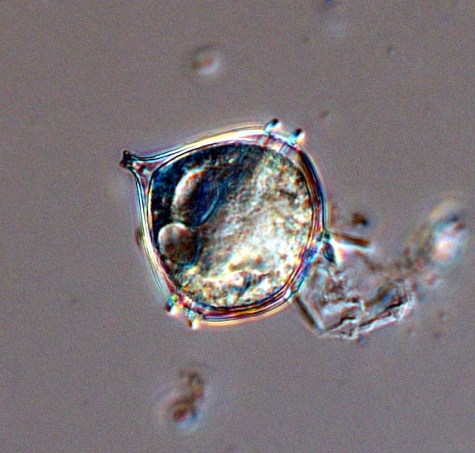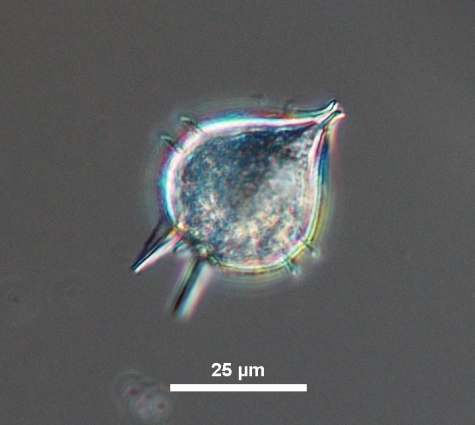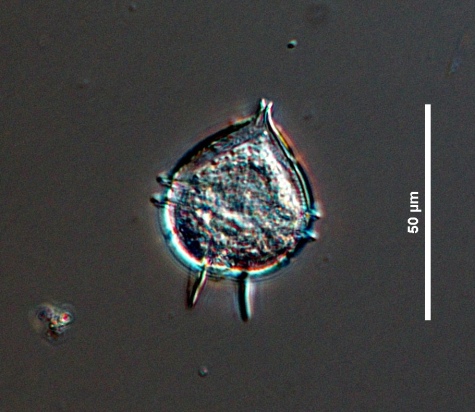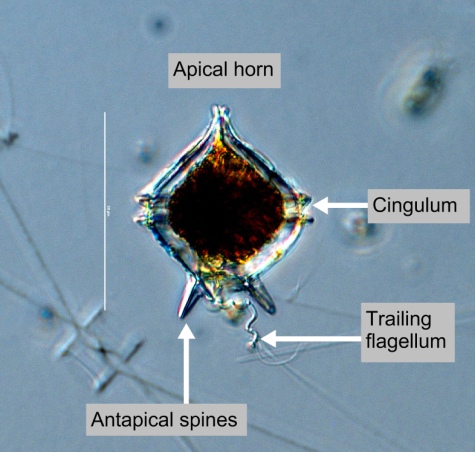



|
Synonym(s)
Peridinium michaelis Stein 1883
(Horner 2002)
Classification
(Guiry and Guiry 2012)
Lifestyle
Resting spore
In diatoms, a cell that requires a dormancy period prior to germination and can survive for several years; usually developed to survive adverse conditions. They are commonly observed in centric but not pennate diatoms. The morphology of the spore may be similar or different from a vegetative cell; they usually have heavily silicified walls and are rich in storage products (Horner 2002).
resting stage (Kraberg et al. 2010). Cells are pink or yellow, depending on their food source. Cells feed by extruding their CloseCytoplasm
In a eukaryotic cell, a gel-like substance within the cell membrane that contains all the organelles except for the nucleus.
cytoplasm out of their theca in the form of a ClosePseudopodium/pseudopodia
A semi-permanent extension of the cytoplasm used for locomotion and feeding by some flagellate protozoans.
pseudopodium and engulfing the prey items. Once it has absorbed the contents of the prey, it retracts itself back into its theca. This is called ClosePallium
(feeding) A mode of feeding used by some heterotrophic dinoflagellates. The dinoflagellate extrudes its cytoplasm, engulfing its food (often a cell or chain of cells). The food is digested outside the dinoflagellate's cell. The dinoflagellate then pulls its cytoplasm and its newly digested meal back inside its theca. This method of feeding allows dinoflagellates to eat food that is bigger than itself.
pallium feeding (Menden-Deuer et al. 2005, Kraberg et al. 2010).Description
Apical
(axis, spine) The region of the apex or point. Refers to the most anterior point or region of the cell (HPP 2003).
apical CloseHorns
The apical or antapical extensions found in some armoured dinoflagellates; they contain cytoplasm, are covered in thecal plates and can be hollow or partially solid (Horner 2002).
horn (Horner 2002). The CloseHypotheca
In thecate dinoflagellates, the posterior part of a dinokont cell above the cingulum. The equivalent of a hypocone for naked dinoflagellates.
hypotheca is round and has two three-winged long spines (Horner 2002).Measurements
Width: 22 - 44 μm
(Kraberg et al. 2010)
Similar species
Harmful effects
Habitat
Distribution
P. steinii has a worldwide distribution (Kraberg et al. 2010).
It is commonly seen in coastal waters in the summer to autumn (Kraberg et al. 2010).
Growth conditions
Environmental Ranges
Temperature range (°C): 2.465 - 25.489
Nitrate (μmol L-1): 0.149 - 9.593
Salinity: 33.935 - 35.667
Oxygen (mL L-1): 4.709 - 7.728
Phosphate (μmol L-1): 0.074 - 1.452
Close
Silicic acid
A general term to describe chemical compounds containing silicon, oxygen and hydrogen with a general formula of [SiOx(OH)4-2x]n. Diatoms polymerize silicic acid into biogenic silica to form their frustules (Azam and Chisholm 1976).
Silicate (μmol L-1): 1.245 - 10.970(EOL 2012)
Bloom characteristics
References
Encylopedia of Life (EOL). 2012. Protoperidinium steinii (Jorgensen) Balech 1974. http://eol.org/pages/900859/details. Accessed 24 Mar 2012.
Guiry, M. D. and Guiry, G. M. 2012. Protoperidinium steinii (Jorgensen) Balech 1974. http://www.algaebase.org/search/species/detail/?species_id=52678. Accessed 14 Mar 2012.
Horner, R. A. 2002. A Taxonomic Guide To Some Common Phytoplankton. Biopress Limited, Dorset Press, Dorchester, UK. 200.
Kraberg, A., Baumann, M. and Durselen, C. D. 2010. Coastal Phytoplankton Photo Guide for Northern European Seas. Verlag Dr. Friedrich Pfeil, Munchen, Germany. 203.
Menden-Deuer, S., Lessard, E. J., Satterberg, J. and Grunbaum, D. 2005. Growth rates and starvation survival of three species of the pallium-feeding, thecate dinoflagellate genus Protoperidinium. Aquatic Microbial Ecology. 41: 145-152.
